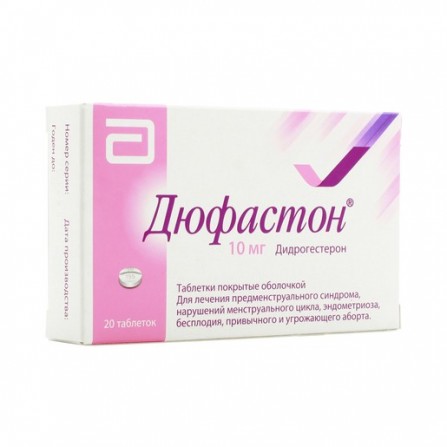Duphaston coated pills 10mg N20
Condition: New product
983 Items
Rating:
Be the first to write a review!

More info
Active ingredients
Didrogesterone
Release form
Pills
Composition
on 1 tablet: Active substances: didrogesterone - 10 mg. Adjuvants: lactose monohydrate - 111.1 mg, hypromellose - 2.8 mg, corn starch - 14 mg, colloidal silicon dioxide - 1.4 mg, magnesium stearate - 0.7 mg. Composition of the shell: opadry white Y-1-7000 (hypromellose, polyethylene glycol 400, titanium dioxide (E171)) - 4 mg.
Pharmacological effect
Analogue of natural progesterone. Didrogesterone in its molecular structure, chemical and pharmacological properties is very close to natural progesterone. Due to the fact that didrogesterone is not a derivative of testosterone, it does not have side effects characteristic of most synthetic progestogens, the so-called androgenic progestogens. Didrogesterone does not possess estrogenic, androgenic, anabolic, glucocorticoid and thermogenic activity. Being a progestogenic component of HRT in menopause, didrogesterone contributes to maintaining the beneficial effect of estrogen on the lipid profile of the blood. However, unlike estrogens, which usually have a negative effect on the blood coagulation system, didrogesterone does not affect the coagulation rates. It does not adversely affect carbohydrate metabolism and liver function. Oral administration of didrogesterone selectively affects the endometrium, thereby preventing an increased risk of endometrial hyperplasia and / or carcinogenesis in the presence of an excess of estrogens. It is indicated in all cases of endogenous progesterone deficiency. Dydrogesterone has no contraceptive action. In the treatment of dydrogesterone, the therapeutic effect is achieved without suppressing ovulation or menstrual dysfunction. Didrogesterone makes it possible to conceive and maintain a pregnancy during treatment.
Pharmacokinetics
After ingestion is rapidly absorbed from the gastrointestinal tract. Cmax in plasma is reached in 2 hours. Plasma protein binding is 97%. Metabolized in the liver by hydroxylation. Excreted in the urine as metabolites - 56-79%. After 24 hours, approximately 85% is eliminated; after 72 hours, the elimination process is almost over.
Indications
Progesterone deficiency: endometriosis; infertility,due to luteal insufficiency; threatened or habitual miscarriage (with progesterone deficiency); premenstrual tension syndrome; dysmenorrhea, irregular menstrual cycle; secondary amenorrhea (in combination therapy with estrogen); dysfunctional uterine bleeding. ZGT: to neutralize the proliferative effect of estrogen on the endometrium in women with disorders caused by natural or surgical menopause in an intact uterus.
Contraindications
Severe liver disease, Dubin-Johnson syndrome, Rotor syndrome, hypersensitivity to didrogesteron.
Use during pregnancy and lactation
If pregnancy is possible, it can be used as indicated. Didrogesterone is excreted in breast milk, so breastfeeding is not recommended during the treatment period.
Dosage and administration
It is applied in accordance with the individual treatment regimen. For oral administration, a single dose is 5-10 mg, a daily dose is 10-30 mg, the frequency of intake is 2-3 times / day.
Side effects
On the part of the digestive system: nausea, diarrhea or constipation may occur; rarely - minor liver dysfunctions, sometimes accompanied by weakness or malaise, jaundice or pain in the stomach. On the endocrine system: discomfort in the mammary glands, uterine bleeding is possible. - skin rash, itching. Allergic reactions: rarely - urticaria; very rarely - angioedema. From the hematopoietic system: in isolated cases - hemolytic anemia. Other: rarely - peripheral edema.
Interaction with other drugs
Inductors of liver microsomal enzymes (including phenobarbital) accelerate the metabolism of didrogesterone and reduce its action.
special instructions
It is used with caution in patients with mild and moderate liver dysfunction, kidney dysfunction, cardiovascular diseases, diabetes mellitus, epilepsy, and migraine. associated with the use of estrogen.




